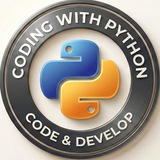#Python #CheatSheet
https://t.iss.one/DataScience4
Please open Telegram to view this post
VIEW IN TELEGRAM
👍8👏1
💥 Here is an amazing Python cheat sheet for you all!
#python #cheatsheet
⚡️ BEST DATA SCIENCE CHANNELS ON TELEGRAM 🌟
#python #cheatsheet
Please open Telegram to view this post
VIEW IN TELEGRAM
👍6🔥1
𝗣𝘆𝘁𝗵𝗼𝗻_𝗖𝗵𝗲𝗮𝘁_𝗦𝗵𝗲𝗲𝘁_𝗳𝗼𝗿_𝗗𝗮𝘁𝗮_𝗘𝗻𝗴𝗶𝗻𝗲𝗲𝗿𝘀.pdf
2.9 MB
𝗣𝘆𝘁𝗵𝗼𝗻 𝗖𝗵𝗲𝗮𝘁 𝗦𝗵𝗲𝗲𝘁 𝗳𝗼𝗿 𝗗𝗮𝘁𝗮 𝗘𝗻𝗴𝗶𝗻𝗲𝗲𝗿𝘀
Whether you're just starting out or already working as a Data Engineer, having a quick Python reference guide can save you time and boost your productivity.
I’m excited to share this Python Cheat Sheet that covers key concepts every data engineer should know — from syntax basics to file handling and commonly used functions. A handy resource for daily use and interview prep.
#Python #DataEngineering #CheatSheet #PythonForData #CodingTips #DataEngineerTools #ProductivityBoost #PythonBasics #InterviewPrep #PythonReference
Join to our WhatsApp📱 channel:
https://whatsapp.com/channel/0029VaC7Weq29753hpcggW2A
Whether you're just starting out or already working as a Data Engineer, having a quick Python reference guide can save you time and boost your productivity.
I’m excited to share this Python Cheat Sheet that covers key concepts every data engineer should know — from syntax basics to file handling and commonly used functions. A handy resource for daily use and interview prep.
#Python #DataEngineering #CheatSheet #PythonForData #CodingTips #DataEngineerTools #ProductivityBoost #PythonBasics #InterviewPrep #PythonReference
Join to our WhatsApp
https://whatsapp.com/channel/0029VaC7Weq29753hpcggW2A
Please open Telegram to view this post
VIEW IN TELEGRAM
👍7❤1
python programming.pdf
3.3 MB
amazing booklet to learn #python 2025
#Python #DataEngineering #CheatSheet #PythonForData #CodingTips #DataEngineerTools #ProductivityBoost #PythonBasics #InterviewPrep #PythonReference
Join to our WhatsApp channel:
https://whatsapp.com/channel/0029VaC7Weq29753hpcggW2A
#Python #DataEngineering #CheatSheet #PythonForData #CodingTips #DataEngineerTools #ProductivityBoost #PythonBasics #InterviewPrep #PythonReference
Join to our WhatsApp channel:
https://whatsapp.com/channel/0029VaC7Weq29753hpcggW2A
👍4
A huge cheat sheet for Python.pdf
357.5 KB
#Python #CheatSheet #PythonTips #LearnPython #PythonProgramming #CodingResources #PythonDevelopers #PythonBasics #CodeFaster #PythonGuide
✉️ Our Telegram channels: https://t.iss.one/addlist/0f6vfFbEMdAwODBk📱 Our WhatsApp channel: https://whatsapp.com/channel/0029VaC7Weq29753hpcggW2A
Please open Telegram to view this post
VIEW IN TELEGRAM
👍5🔥2👏1
💡 Python Lists Cheatsheet: Essential Operations
This lesson provides a quick reference for common Python list operations. Lists are ordered, mutable collections of items, and mastering their use is fundamental for Python programming. This cheatsheet covers creation, access, modification, and utility methods.
Code explanation: This script demonstrates fundamental list operations in Python. It covers creating lists, accessing elements using indexing and slicing, modifying existing elements, adding new items with
#Python #Lists #DataStructures #Programming #Cheatsheet
━━━━━━━━━━━━━━━
By: @DataScience4✨
This lesson provides a quick reference for common Python list operations. Lists are ordered, mutable collections of items, and mastering their use is fundamental for Python programming. This cheatsheet covers creation, access, modification, and utility methods.
# 1. List Creation
my_list = [1, "hello", 3.14, True]
empty_list = []
numbers = list(range(5)) # [0, 1, 2, 3, 4]
# 2. Accessing Elements (Indexing & Slicing)
first_element = my_list[0] # 1
last_element = my_list[-1] # True
sub_list = my_list[1:3] # ["hello", 3.14]
copy_all = my_list[:] # [1, "hello", 3.14, True]
# 3. Modifying Elements
my_list[1] = "world" # my_list is now [1, "world", 3.14, True]
# 4. Adding Elements
my_list.append(False) # [1, "world", 3.14, True, False]
my_list.insert(1, "new item") # [1, "new item", "world", 3.14, True, False]
another_list = [5, 6]
my_list.extend(another_list) # [1, "new item", "world", 3.14, True, False, 5, 6]
# 5. Removing Elements
removed_value = my_list.pop() # Removes and returns last item (6)
removed_at_index = my_list.pop(1) # Removes and returns "new item"
my_list.remove("world") # Removes the first occurrence of "world"
del my_list[0] # Deletes item at index 0 (1)
my_list.clear() # Removes all items, list becomes []
# Re-create for other examples
numbers = [3, 1, 4, 1, 5, 9, 2]
# 6. List Information
list_length = len(numbers) # 7
count_ones = numbers.count(1) # 2
index_of_five = numbers.index(5) # 4 (first occurrence)
is_present = 9 in numbers # True
is_not_present = 10 not in numbers # True
# 7. Sorting
numbers_sorted_asc = sorted(numbers) # Returns new list: [1, 1, 2, 3, 4, 5, 9]
numbers.sort(reverse=True) # Sorts in-place: [9, 5, 4, 3, 2, 1, 1]
# 8. Reversing
numbers.reverse() # Reverses in-place: [1, 1, 2, 3, 4, 5, 9]
# 9. Iteration
for item in numbers:
# print(item)
pass # Placeholder for loop body
# 10. List Comprehensions (Concise creation/transformation)
squares = [x**2 for x in range(5)] # [0, 1, 4, 9, 16]
even_numbers = [x for x in numbers if x % 2 == 0] # [2, 4]
Code explanation: This script demonstrates fundamental list operations in Python. It covers creating lists, accessing elements using indexing and slicing, modifying existing elements, adding new items with
append(), insert(), and extend(), and removing items using pop(), remove(), del, and clear(). It also shows how to get list information like length (len()), item counts (count()), and indices (index()), check for item existence (in), sort (sort(), sorted()), reverse (reverse()), and iterate through lists. Finally, it illustrates list comprehensions for concise list generation and filtering.#Python #Lists #DataStructures #Programming #Cheatsheet
━━━━━━━━━━━━━━━
By: @DataScience4
Please open Telegram to view this post
VIEW IN TELEGRAM
❤2
